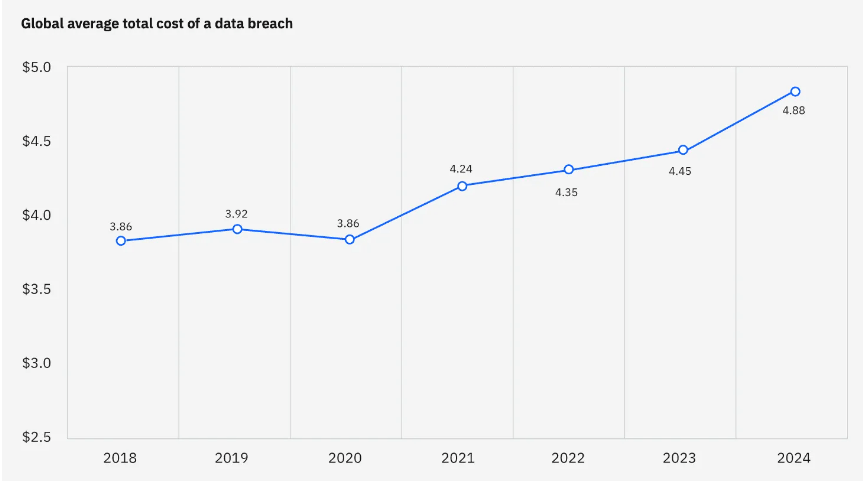EXECUTIVE SUMMARY:
Global data breach costs have hit an all-time high, according to IBM’s annual Cost of a Data Breach report. The tech giant collaborated with the Ponemon institute to study more than 600 organizational breaches between March of 2023 and February of 2024.
The breaches affected 17 industries, across 16 countries and regions, and involved leaks of 2,000-113,000 records per breach. Here’s what researchers found…
Essential information
The global average cost of a data breach is $4.88 million, up nearly 10% from last year’s $4.5 million. Key drivers of the year-over-year cost spike included post-breach third-party expenses, along with lost business.

Over 50% of organizations that were interviewed said that they are passing the breach costs on to customers through higher prices for goods and services.
More key findings
- For the 14th consecutive year, the U.S. has the highest average data breach costs worldwide; nearly $9.4 million.
- In the last year, Canada and Japan both experienced drops in average breach costs.
- Most breaches could be traced back to one of two sources – stolen credentials or a phishing email.
- Seventy percent of organizations noted that breaches led to “significant” or “very significant” levels of disruption.
Deep-dive insights: AI
The report also observed that an increasing number of organizations are adopting artificial intelligence and automation to prevent breaches. Nearly two-thirds of organizations were found to have deployed AI and automation technologies across security operations centers.
The use of AI prevention workflows reduced the average cost of a breach by $2.2 million. Organizations without AI prevention workflows did not experience these cost savings.
Right now, only 20% of organizations report using gen AI security tools. However, those that have implemented them note a net positive effect. GenAI security tools can mitigate the average cost of a breach by more than $167,000, according to the report.
Deep-dive insights: Cloud
Multi-environment cloud breaches were found to cost more than $5 million to contend with, on average. Out of all breach types, they also took the longest time to identify and contain, reflecting the challenge that is identifying data and protecting it.
In regards to cloud-based breaches, commonly stolen data types included personal identifying information (PII) and intellectual property (IP).
As generative AI initiatives draw this data into new programs and processes, cyber security professionals are encouraged to reassess corresponding security and access controls.
The role of staffing issues
A number of organizations that contended with cyber attacks were found to have under-staffed cyber security teams. Staffing shortages are up 26% compared to last year.
Organizations with cyber security staff shortages averaged an additional $1.76 million in breach costs as compared to organizations with minimal or no staffing issues.
Staffing issues may be contributing to the increased use of AI and automation, which again, have been shown to reduce breach costs.
Further information
For more AI and cloud insights, click here. Access the Cost of a Data Breach 2024 report here. Lastly, to receive cyber security thought leadership articles, groundbreaking research and emerging threat analyses each week, subscribe to the CyberTalk.org newsletter.

